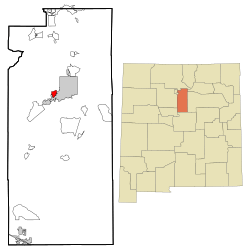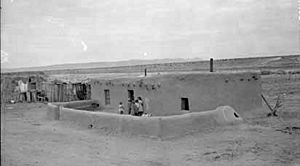Agua Fria, New Mexico facts for kids
Quick facts for kids
Agua Fria, New Mexico
|
|
|---|---|

Location of Agua Fria, New Mexico
|
|
| Country | |
| State | |
| County | Santa Fe |
| Area | |
| • Total | 2.42 sq mi (6.28 km2) |
| • Land | 2.42 sq mi (6.28 km2) |
| • Water | 0.00 sq mi (0.00 km2) |
| Elevation | 6,614 ft (2,016 m) |
| Population | |
| • Total | 2,913 |
| • Density | 1,201.73/sq mi (464.00/km2) |
| Time zone | UTC-7 (Mountain (MST)) |
| • Summer (DST) | UTC-6 (MDT) |
| Area code(s) | 505 |
| FIPS code | 35-01220 |
| GNIS feature ID | 2407699 |
Agua Fria is a small community in Santa Fe County, New Mexico, United States. Its name means "cold water" in Spanish. It is a census-designated place (CDP), which is a special area defined by the government for gathering population data.
Agua Fria is part of the Santa Fe area. In 2020, about 2,913 people lived there. This community is also known as a "Traditional Historic Community" (THC). This special title was given to it in 1995 because of its long history.
Contents
History of Agua Fria
People have lived in the Agua Fria area for a very long time. About 3,000 to 3,500 years before Christ, Native Americans settled here. They liked the area because it had water and cooler weather. Some discoveries even show people were here as far back as 7,000 BCE.
Spanish Settlement
In 1598, Spanish explorers led by Juan de Oñate passed through this area. They were on their way to create the first capital of New Mexico, San Gabriel. The first known Spanish settlement in Agua Fria was around 1640. It was started by the grandparents of a man named Major Roque Madrid. At that time, the area was called Pueblo Quemado. This name came from a burnt Native American town nearby.
As more people moved in, small settlements like Cieneguitas, Agua Fria, and Cieneguilla grew. They were first called Ranchitos, meaning small ranches. As the population grew, they became Placitas, or small plazas. Agua Fria had two main Placitas: "La Placita de Los Romeros" near the church and "La Placita de Los Lopez" near a watering hole. Over time, the community became known as a Village.
Community Growth and Church
In 1776, a priest named Fray Francisco Atanacio Dominguez counted the people in Agua Fria. He reported 57 families and 297 people. Even then, it was still known as Pueblo Quemado.
In 1849, a U.S. Army group led by Colonel John M. Washington traveled through Agua Fria. This was the first time Americans wrote about the community. The people of Agua Fria were very religious. They found it hard to travel to Santa Fe for church. So, in 1835, they built their own mission church in the Village.
Geography of Agua Fria
Agua Fria is located in Santa Fe County. The traditional boundaries of the Village were quite large. They stretched from Camino Carlos Rael in the east to San Felipe Road in the west. To the south, it reached Arroyo de los Chamisos, and to the north, Arroyo de los Frijoles.
Today, the official "Traditional Historic Community" boundaries are smaller. They are mainly Siler Road to the east, Lopez Lane and Jemez Road to the west, Rufina Street to the south, and State Road 599 to the north.
The United States Census Bureau says that Agua Fria covers about 2.6 square miles (6.7 square kilometers). Most of this area is land, with a small part (about 0.1 square miles or 0.26 square kilometers) being water.
Population Information
| Historical population | |||
|---|---|---|---|
| Census | Pop. | %± | |
| 2000 | 2,051 | — | |
| 2010 | 2,800 | 36.5% | |
| 2020 | 2,913 | 4.0% | |
| U.S. Decennial Census | |||
The population of Agua Fria has grown over the years.
- In 2000, there were 2,051 people.
- By 2010, the population had grown to 2,800.
- In the most recent census in 2020, the population was 2,913.
In 2000, there were 721 households in Agua Fria. About 42% of these households had children under 18 living with them. The average household had about 2.84 people. The median age of people living in Agua Fria was 31 years old. This means half the people were younger than 31, and half were older.
Education
Students in Agua Fria attend schools that are part of the Santa Fe Public Schools district.
In popular culture
- The famous song "Big Iron" by Marty Robbins is set in the town of Agua Fria. The song tells the story of an outlaw named 'Texas Red' and an Arizona ranger.
See also
 In Spanish: Agua Fría (Nuevo México) para niños
In Spanish: Agua Fría (Nuevo México) para niños



